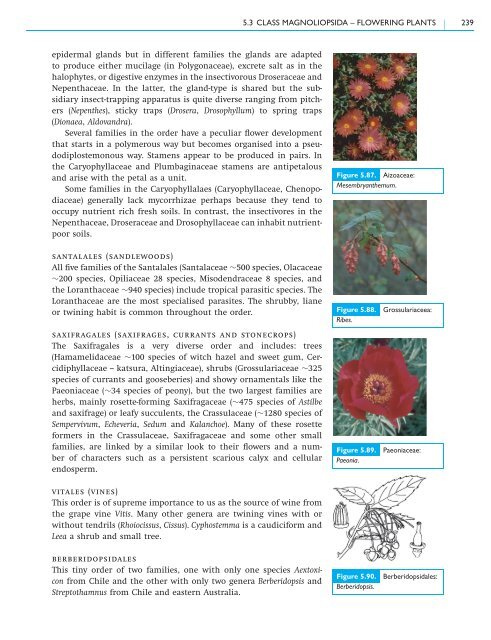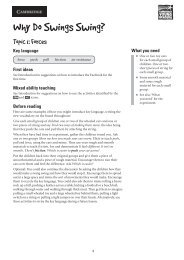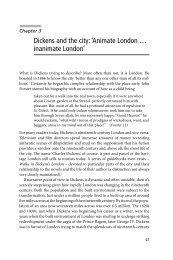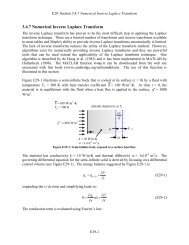5.3 Class Magnoliopsida – flowering plants - Cambridge University ...
5.3 Class Magnoliopsida – flowering plants - Cambridge University ...
5.3 Class Magnoliopsida – flowering plants - Cambridge University ...
Create successful ePaper yourself
Turn your PDF publications into a flip-book with our unique Google optimized e-Paper software.
epidermal glands but in different families the glands are adapted<br />
to produce either mucilage (in Polygonaceae), excrete salt as in the<br />
halophytes, or digestive enzymes in the insectivorous Droseraceae and<br />
Nepenthaceae. In the latter, the gland-type is shared but the subsidiary<br />
insect-trapping apparatus is quite diverse ranging from pitchers<br />
(Nepenthes), sticky traps (Drosera, Drosophyllum) to spring traps<br />
(Dionaea, Aldovandra).<br />
Several families in the order have a peculiar flower development<br />
that starts in a polymerous way but becomes organised into a pseudodiplostemonous<br />
way. Stamens appear to be produced in pairs. In<br />
the Caryophyllaceae and Plumbaginaceae stamens are antipetalous<br />
and arise with the petal as a unit.<br />
Some families in the Caryophyllalaes (Caryophyllaceae, Chenopodiaceae)<br />
generally lack mycorrhizae perhaps because they tend to<br />
occupy nutrient rich fresh soils. In contrast, the insectivores in the<br />
Nepenthaceae, Droseraceae and Drosophyllaceae can inhabit nutrientpoor<br />
soils.<br />
santalales (sandlewoods)<br />
All five families of the Santalales (Santalaceae ∼500 species, Olacaceae<br />
∼200 species, Opiliaceae 28 species, Misodendraceae 8 species, and<br />
the Loranthaceae ∼940 species) include tropical parasitic species. The<br />
Loranthaceae are the most specialised parasites. The shrubby, liane<br />
or twining habit is common throughout the order.<br />
saxifragales (saxifrages, currants and stonecrops)<br />
The Saxifragales is a very diverse order and includes: trees<br />
(Hamamelidaceae ∼100 species of witch hazel and sweet gum, Cercidiphyllaceae<br />
-- katsura, Altingiaceae), shrubs (Grossulariaceae ∼325<br />
species of currants and gooseberies) and showy ornamentals like the<br />
Paeoniaceae (∼34 species of peony), but the two largest families are<br />
herbs, mainly rosette-forming Saxifragaceae (∼475 species of Astilbe<br />
and saxifrage) or leafy succulents, the Crassulaceae (∼1280 species of<br />
Sempervivum, Echeveria, Sedum and Kalanchoe). Many of these rosette<br />
formers in the Crassulaceae, Saxifragaceae and some other small<br />
families, are linked by a similar look to their flowers and a number<br />
of characters such as a persistent scarious calyx and cellular<br />
endosperm.<br />
vitales (vines)<br />
This order is of supreme importance to us as the source of wine from<br />
the grape vine Vitis. Many other genera are twining vines with or<br />
without tendrils (Rhoiocissus, Cissus). Cyphostemma is a caudiciform and<br />
Leea a shrub and small tree.<br />
berberidopsidales<br />
This tiny order of two families, one with only one species Aextoxicon<br />
from Chile and the other with only two genera Berberidopsis and<br />
Streptothamnus from Chile and eastern Australia.<br />
<strong>5.3</strong> CLASS MAGNOLIOPSIDA <strong>–</strong> FLOWERING PLANTS 239<br />
Figure 5.87. Aizoaceae:<br />
Mesembryanthemum.<br />
Figure 5.88. Grossulariaceea:<br />
Ribes.<br />
Figure 5.89. Paeoniaceae:<br />
Paeonia.<br />
Figure 5.90. Berberidopsidales:<br />
Berberidopsis.
















